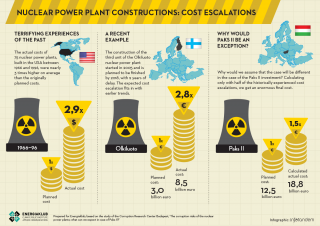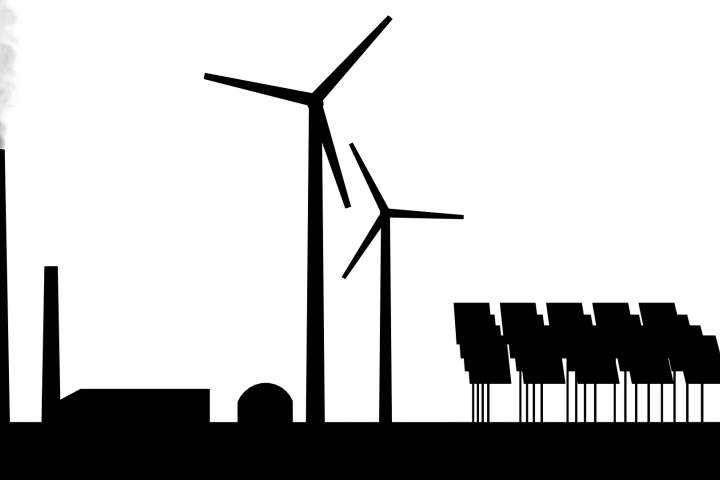Alternatives of nuclear energy in Hungary
There is no need for Paks II, as Hungary could supply its future energy needs without a new nuclear power plant. This was revealed by a study, prepared by Energiaklub, which proposes a much more favorable solution instead of this single, unnecessary 12 billion Euro investment. All this can be achieved by rationalizing energy consumption, carrying out developments on the field of energy efficiency, reaching a high share of renewables and establishing a flexible, decentralized energy system.
The sixth, all day long conference of the series ’Seriously about Paks’ was about the alternatives of Paks II.
In the morning program Felix Matthes held two presentations. In the first, he introduced the process of the decision making on the German Energy Transition. According to him, the change in the German energy policy, concretely, the decision on the phase out of nuclear energy in Germany in 2011-2012 was not a surprise – there was a long history of it.
The process started in 1975 and lasted for decades. So the decision on the shutdown of the nuclear power plants was not simply a decision of Chancellor Angela Merkel in the shadow of the Fukushima disaster. The need for the change in the German energy policy was increased by the Chernobyl accident, and the real debate started in the nineties. Firstly, all of the Soviet design nuclear units were shut down in the eastern part of Germany, after the reunification in 1990. After that both green/leftish and conservative governments continuously made stricter and stricter the rules concerning the operation of nuclear reactors. As a consequence 40% of all nuclear capacities have been taken offline by 2015, and the share of renewable has reached 30%.
The German government decided that energy production of the country will be free of nuclear energy by 2022. The target of the Energy Transition is that there will be 50% increase in the efficiency concerning the use of electricity and an 80-95% decrease in the emission of greenhouse gases by 2050. The importance of R&D is highlighted especially in terms of serving the targets concerning renewable energy, namely, that the share of green energy sources will reach 60% by the mid of the century in the energy supply of Germany.
There were ethical considerations also when the decision was made: although the chance of a nuclear accident is extremely low, consequences would be tremendous. On the top of that, financial considerations also should be taken into account: the costs of a nuclear disaster could reach 3000 billion of Euros, which is sixth time more than the German GDP – this kind of risks are unacceptable for the majority of the German society.
The low carbon energy sources mean a real alternative for German people. The debate is not about risks anymore, but is about competitiveness on the long run, including the rising costs of CO2 emissions.
In his second presentation, Felix Matthes introduced the status of the Energy Transition and its perspectives. He said that the 2020 target of the share of renewables might be increased to 35%, and could reach 80% by 2050. An important fundament of the transition is the energy conservation.
According to energy models, in certain periods of time 100% of the energy needs could be supplied by renewables in the 2020-2030 decades. As a result of the transition, base load power plants will disappear off the energy system, as there will be no need for those anymore. The energy production sector has already changed significantly – besides some 700 conventional power plants, 1.2 million PV, 30 thousand wind power plants, 10 thousand biomass power plants and 30 thousand small and mid-size CHP plants are in operation. 90% of the production capacities are owned by not large energy companies, but private people, farmers, hedge funds, banks, real estate developers.
The next speaker was Ada Ámon, who stated that there is no need for Paks II, as Hungary could supply its future energy needs without a new nuclear power plant. This was revealed by a study, prepared by Energiaklub, which proposes a much more favorable solution instead of this single, unnecessary 12 billion Euro investment.
All this can be achieved by rationalizing energy consumption, carrying out developments on the field of energy efficiency, reaching a high share of renewables and establishing a flexible, decentralized energy system.
At the moment, there is no need for launching the Paks II project in a hurry. There is possibility to implement a thorough public and expert debate. Only after every argument from all sides has been discussed, besides full transparency of information, can a decision be made on the future energy system of Hungary, and after all that should the necessary measures be determined.
The energy vision of Energiaklub describes how the energy system of Hungary could look like in 2030. The date 2030 was chosen as it is the target date of the new energy and climate policy of the EU and the Energy Policy of Hungary as well. 15 years is an appropriate period of time for planning even on the field of energy and is long enough for starting the necessary changes. Energiaklub estimated that electricity demand would be lower than suggested by the forecast used to make the case for Paks II, therefore more time would available to address missing capacities
Constructing the new NPP would determine what the energy system of Hungary will look like: centralized, so controlled by several large power plants and big companies, instead of a decentralized system which uses locally available renewable sources and which takes sustainability into account also.
The vision of Energiaklub, which prefers the latter, is in line with the plans of the EU. This is the only way to be able to adapt with success to the future technology and economic challenges. It would increase the safety of supply, decrease the dependence on the Russian import, create jobs, increase the country's ability to retain earnings and contributing to the development of the national innovation.
In order to test the feasibility of the vision, Energiaklub has utilized the Danish EnergyPLAN software. This program has been used worldwide since 1999 to help conduct and analyze scientific research and alternative visions in countries such as Great-Britain, Ireland, the USA, and China. The alternative solutions prepared by the Danish software developers have played an important role in shifting Denmark’s official energy strategy to renewables only by 2050.
The software can model the entire energy economy of a country or a region, in other words, all types of energy demands of all sectors, including the public sector, agriculture, industry, services and transportation. The EnergyPLAN models the entire one-year operations of an energy system and analyses it by the hour. This feature was fundamental when selecting the software because of the weather-dependent renewables and the continuous fluctuation in electricity demand.
The program’s appropriateness for the Hungarian context was verified by creating a domestic energy model for the year 2011. The difference between the program’s results and the actual statistics for the same year was marginal.
The modeling of Energiaklub’s 2030 vision has the following results:
-the domestic energy system is sustainable without Paks II by 2030;
-the total electricity demand grows at a slower rate than officially forecasted (50,6 TWh); instead from the 40.2 TWh in 2012 it is expected to grow to 47.1 TWh by 2030
-the ratio of renewables used in power generation, even by conservative estimates, is more than 27%
-the electricity import is at minimum: 0.7 TWh (11.9 TWh in 2013);
-the resources needed for heating drops by 24% due to the energy efficiency investments and the new, low energy consumption buildings;
-the use of alternative fuel vehicles (gas, hybrid, electric) reaches 20%, and 30% of the transport of goods is shifted to railroads
- the country’s total resources demand is 3% lower than in 2011
The findings clearly show that there are alternative to Paks II. Energiaklub plans further studies: based on the above mentioned findings, a financial analysis to the 2030 vision will be prepared to enable a comparison with the Paks II plans of the government. At last, an additional model will be prepared for the decades after 2030 to examine the operations of the Hungarian energy system without nuclear energy.
In the afternoon program of the conference, leaders of professional organizations of the Hungarian renewable industries met. In the panel discussion, representatives of solar and wind energy, geothermal energy, solid biomass and biogas based power generation technologies were involved. The experts agreed that the plans contained in Energiaklub’s model are feasible.
"The solar technology comes as a roller." – said Ádám Szolnoki, president of the Hungarian Photovoltaic Industry Association. "The association made a calculation of the solar cell proliferation, and also under very conservative assumptions, we decided that 1200 MW capacity can be established in Hungary only on a market basis, without any particular stimulus or state aid" - he added.
Péter Lendvay, leader of the Hungarian Wind Energy Association pointed out that 2016 will be the tenth year in a row without printing out a single tender for construction of new wind farm applications in Hungary. Lendvay think that along the gradual preparation of the current network, the system can handle more and more wind turbines, and he said that according to a previous tender 1200 MW of wind capacity can be acceptable now.
President of the Hungarian Biogas Association, dr. Kornél Kovács also sees the targets in Energiaklub’s plan available, but then about 750 biogas plants should work in Hungary instead of 45. The president complained about the "incredibly difficult" licensing of a new plant, as currently signatures/stamps have to be obtained from twenty-four different state agencies.









